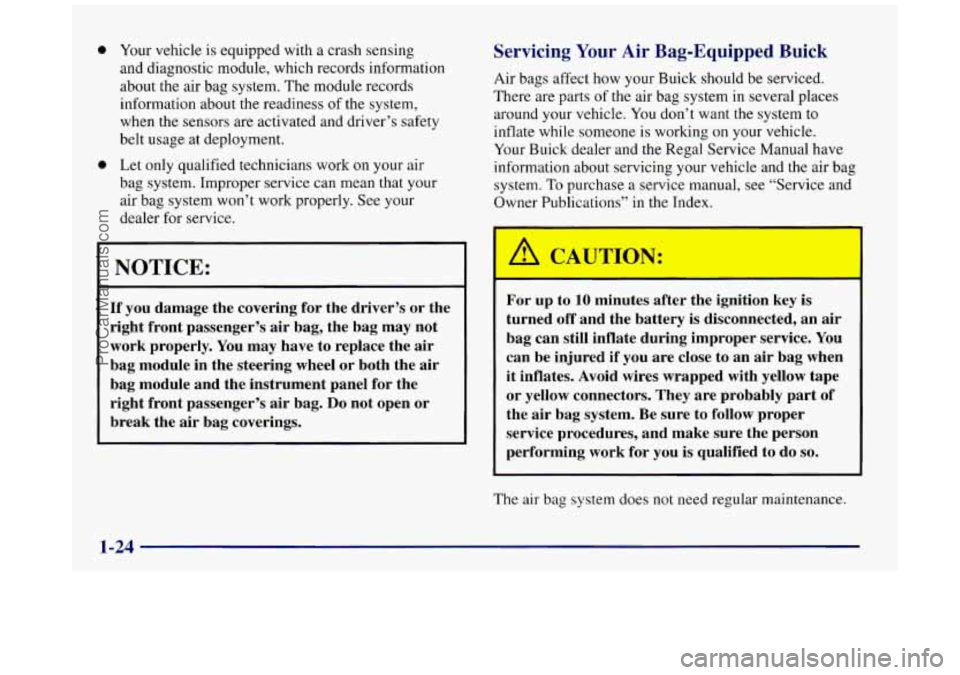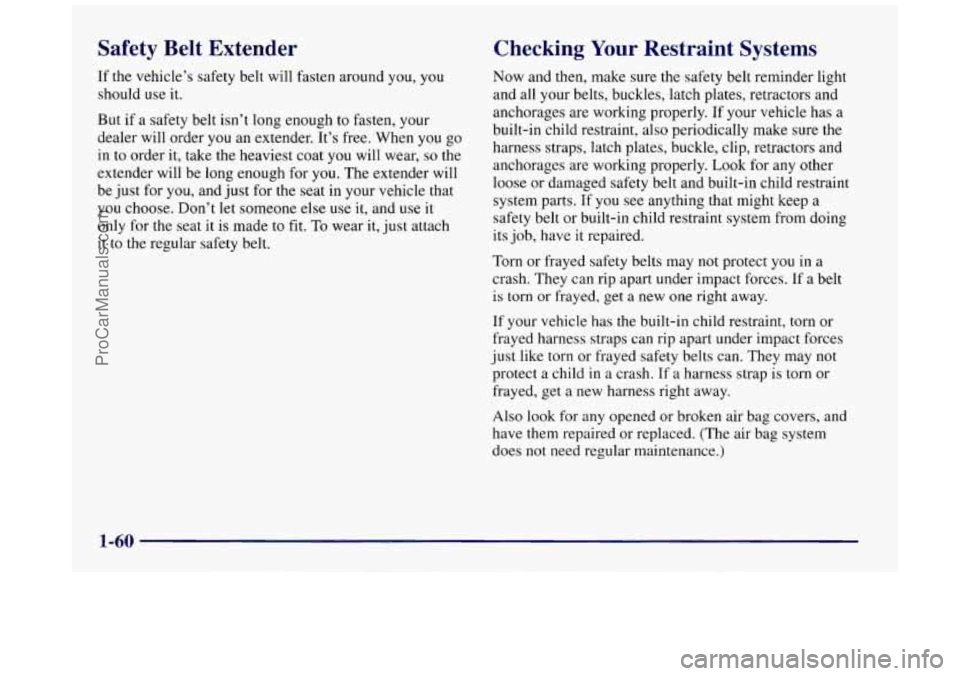1997 BUICK REGAL maintenance
[x] Cancel search: maintenancePage 5 of 422

The 1997 Buick Regal Owner’s Manual
1-1
2- 1
3- 1
4- 1
5- 1
6- 1
7- 1
8- 1
9- 1
Seats and Restraint Systems
This section tells you how to use your seats and safety belts properly. It also explains the “air bag” system.
Features and Controls
This section explains how to start and operate your Buick.
Comfort Controls and Audio Systems
This section tells you how to adjust the ventilation and comfort controls and how to operate your audio system.
Your Driving and the Road
Here you’ll find helpful information and tips about the road and how to drive under different conditions.
Problems on the Road
This section tells what to do if you have a problem while driving, such as a flat tire or overheated engine, etc.
Service and Appearance Care
Here the manual tells you how to keep your Buick running properly and looking good.
Maintenance Schedule
This section tells you when to perform vehicle maintenance and what fluids and lubricants to use.
Customer Assistance Information
This section tells you how to contact Buick for assistance and how to get service and owner publications.
It also gives you information on “Reporting Safety Defects’’ on page
8-8.
Index
Here’s an alphabetical listing of almost every subject in this manual. You can use it to quickly find
something you want
to read.
i
-
ProCarManuals.com
Page 38 of 422

0
0
Your vehicle is equipped with a crash sensing
and diagnostic module, which records information
about the air bag system. The module records
information about the readiness
of the system,
when the sensors are activated and driver’s safety
belt usage at deployment.
Let only qualified technicians work on your air
bag system. Improper service can mean that your
air bag system won’t work properly. See your
dealer for service.
NOTICE:
If you damage the covering for the driver’s or the
right front passenger’s air bag, the bag may not
work properly. You may have to replace the air
bag module in the steering wheel or both the air
bag module and the instrument panel for the
right front passenger’s air bag.
Do not open or
break the air bag coverings.
Servicing Your Air Bag-Equipped Buick
Air bags affect how your Buick should be serviced.
There are parts of the air bag system in several places
around your vehicle. You don’t want the system to
inflate while someone is working on your vehicle.
Your Buick dealer and the Regal Service Manual have
information about servicing your vehicle and the air bag
system.
To purchase a service manual, see “Service and
Owner Publications” in the Index.
I
UTION:
I
For up to 10 minutes after the ignition key is
turned off and the battery is disconnected, an air
bag can still inflate during improper service. You
can be injured if you are close to an air bag when
it inflates. Avoid wires wrapped with yellow tape
or yellow connectors. They
are probably part of
the air bag system. Be sure to follow proper
service procedures, and make sure the person
performing work for you is qualified to do
so.
The air bag system does not need regular maintenance.
I
ProCarManuals.com
Page 74 of 422

Safety Belt Extender
If the vehicle’s safety belt will fasten around you, you
should use
it.
But if a safety belt isn’t long enough to fasten, your
dealer will order you an extender. It’s free. When you go
in to order it, take the heaviest coat you will wear, so the
extender will be long enough for you. The extender will
be just for you, and just for the seat in your vehicle that
you choose. Don’t
let someone else use it, and use it
only for the seat it is made to fit. To wear it, just attach
it to the regular safety belt.
Checking Your Restraint Systems
Now and then, make sure the safety belt reminder light
and all your belts, buckles, latch plates, retractors and
anchorages are working properly. If your vehicle has a
built-in child restraint, also periodically make sure the
harness straps, latch plates, buckle, clip, retractors and
anchorages are working properly.
Look for any other
loose or damaged safety belt and built-in child restraint
system parts. If you see anything that might keep a
safety belt or built-in child restraint system from doing
its job, have
it repaired.
Torn or frayed safety belts may not protect you in
a
crash. They can rip apart under impact forces. If a belt
is torn or frayed, get a new one right away.
If your vehicle has the built-in child restraint, torn or
frayed harness straps can rip apart under impact forces
just like torn or frayed safety belts can. They may not
protect a child in a crash. If a harness strap is torn or
frayed, get a new harness right away.
Also look for any opened or broken air bag covers, and
have them repaired or replaced. (The air bag system
does not need regular maintenance.)
1-60
ProCarManuals.com
Page 143 of 422

Tire Pressure Monitor Light
LOW
TI RE
The tire pressure monitor
system can alert you to
a
large change in the pressure
in
one tire. The system
won’t alert you before you
drive that a tire is low or
flat. Each time you start
your Buick, you must drive
10 to
20 miles (15 to 30 km)
before the system will
work properly.
After you’ve driven
10 to 20 miles (15 to 30 km), the
LOW TIRE light will come on if the pressure in one tire
becomes at least 10 psi
(69 kPa) higher or lower than the
other three tires. The tire pressure monitor system
detects differences in tire rotation speeds that are caused
by changes in tire pressure. It will not alert you
if the
pressure in more than one tire is low or high or
if the
system is not calibrated properly.
The system can alert
you about a low tire
-- but it doesn’t measure tire
pressure, and it doesn’t replace normal tire maintenance.
See “Tires’’
in the Index.
When the LOW TIRE light comes
on, you should stop
as soon as you can and check all your tires for damage. (If
a tire
is flat, see “If a Tire Goes Flat” in the Index.)
Also, check the tire pressure in all four tires as soon
as
you can. (See “Inflation - Tire Pressure” in the Index.)
The
LOW TIRE light will
stay on until you turn off
the ignition or press the red
RESET button, which is
located inside your
instrument panel fuse block.
(It’s the first button in
the
top row of the fuse block.)
Don’t press the RESET button without first checking
and adjusting the pressure in all four tires.
If you press
the button when the tire pressure is incorrect,
the check
tire pressure system will not work properly
and may
not alert you when a tire is low.
Any time
you adjust the tire pressure, you’ll need to
calibrate the check tire pressure system.
You’ll also neea
to calibrate the system whenever you buy new tires,
have tires repaired or rotate your tires.
ProCarManuals.com
Page 153 of 422

Driver Information Center (Option)
- PSI kPa
INST- - -MPG %
AvGmm B 4
OIL umh! L/lOO km
LIFERANGE
SC BOOST
3.8L L67 Supercharged Engine
AvGmm n
INST- - -MPG%
OIL u.h!L/iOO krn
LIFERANGE
3.8L L36 Engine
Your Driver Information Center, (DIC) located below
the tachometer
on the instrument panel cluster, gives
you important safety and maintenance facts. When you
turn the ignition on, the entire center lights up for a few
seconds. Then it goes
to work.
ProCarManuals.com
Page 155 of 422

OIL LIFE MONITOR: Shows an estimate of the oil’s RANGE: Shows the approximate distance you can
remaining useful life. When the oil life index is less than drive without refueling. This is based on the amount
of
lo%, the CHANGE OIL SOON light will come on. fuel in the
tank and on the fuel economy of the most
When you have the oil changed according to the recent 25 miles. Pressing
RESET while in this mode
maintenance schedule (see “Maintenance Schedule” in will have
no effect.
the Index),
YOU will have to reset the oil life monitor. TO BOOST GAGE: If you have the supercharged engine,
five seconds while the oil life monitor is being displayed receiving. Pressing RESET while in this mode will have
on the DIC. The
oil life will change to 100%.
do this, press and hold the RESET button for than this gage will show the amount of boost your engine is
no effect.
ProCarManuals.com
Page 158 of 422

Comfort Controls
Manual Single Zone Climate Control
COMFORT CONTROL II
With this system, you can control the heating, cooling
and ventilation in your vehicle, The system works best if
you keep your windows closed while using it.
Fan Knob
The left knob selects the amount of air you want. To turn
the fan off, turn the knob to
OFF.
If the airflow seems very low when the fan knob is turned
to
the highest setting, regardless of the mode setting, your
passenger compartment air filter may need to be replaced. See “Maintenance Schedule”
in the Index.
Temperature Knob
The center knob changes the temperature of the air
coming through the system. Turn this knob toward red
(clockwise) for warmer air. Turn it toward blue
(counterclockwise) for cooler air.
Mode Knob
The right knob has several settings to control the
direction of airflow:
MAX: This setting recirculates much of the air inside
your vehicle and sends it through the instrument panel
outlets. The air conditioning compressor will run
automatically
in this setting unless the outside
temperature is below
40°F (4°C). (Even when the
compressor is running,
you can control the temperature.)
NORM: This setting brings in outside air and sends
it through the instrument panel outlets. The air
conditioning compressor will run automatically in
this setting unless the outside temperature
is below
40°F (4°C). (Even when the compressor is running,
you can control the temperature.)
3-2
ProCarManuals.com
Page 160 of 422

Heating
On cold days, use HTR with the temperature knob all
the way in the red area. The system will bring in outside
air, heat
it and send it to the floor ducts.
If your vehicle has an engine coolant heater, you can use
it to help your system provide warm air faster when it’s
cold outside
(0°F (- 18 O C) or lower). An engine coolant
heater warms the coolant your engine and heating
system use to provide heat. See “Engine Coolant
Heater” in the Index.
Ventilation
For mild outside temperatures when little heating or
cooling is needed, use VENT to direct outside air
through your vehicle. Your vehicle also has the
flow-through ventilation system described later in
this section.
Defogging and Defrosting
Your system has two settings for clearing the front and
side windows.
To defrost the windows quickly, use
FRONT with the temperature knob all the way in the red
area.
To warm passengers while keeping the windows
clear, use
BLEND.
Dual ComforTemp Climate Control
(If Equipped)
I_ .
With this system, the driver and passenger can maintain
separate temperatures. The system works best if you
keep your windows closed while using it.
Fan Control
The left knob labeled FAN controls the fan speed selection.
If the airflow seems very low when the fan knob is turned
to the highest setting regardless
of the mode setting, your
passenger compartment air filter may need to be replaced. See “Maintenance Schedule’’ in the Index.
Driver’s Temperature Knob
The center knob sets the temperature for the driver’s
outlets.
Turn the knob toward red (clockwise) for warmer
air. Turn it toward blue (counterclockwise) for cooler air.
3-4
ProCarManuals.com